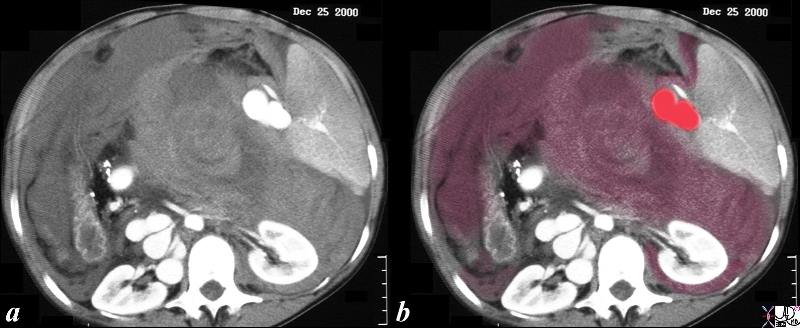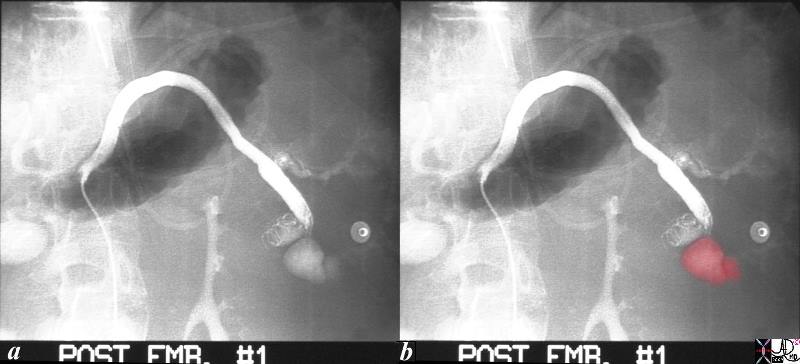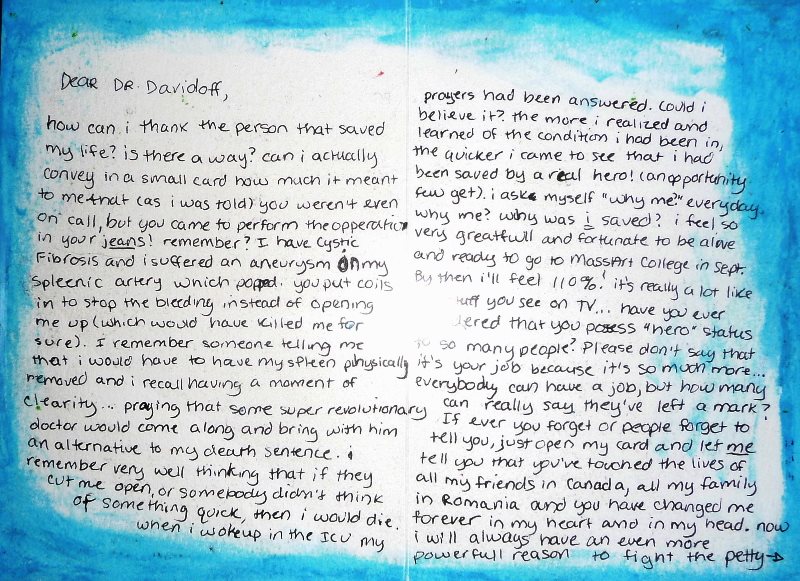It was Christmas night 20.. and life dealt a shocking event for an 18 year old who had already a suffered all her young life with ill health caused by a familial and congenital disorder called cystic fibrosis. She had been dealt a bum deal – but this night she was at deaths door.
I received a middle of night call – “Dr Davidoff – I know you are not on call but the person covering the radiology service is not trained in interventional angiography and we have an 18 year old with a pressure of 70mmhg – and there is no way out for her. Dr Nilima Patwardhan has her in the OR but realizes that if she operates it will be disaster since the CTscan shows blood throughout the abdominal cavity.
I was at U Mass at the time which is located in Worcester – about 30 miles from Boston. The technologists and nurses necessary for such a procedure live in scattered rural areas around the hospital and we knew it would be an hour before we could start the procedure.
“Dr Patwardhan wants you to get your butt in here ASAP!”
I had made this middle of the night trip many times – sometimes more than twice in a night -also in the heat of the humid summers and in the cold and dangers of snow and ice. Either way the trip gave me time clear my mind and prepare for the procedure, and think of possibilities and alternatives, and calm the adrenaline that inevitably ran the length of my vessels.
My first step was to review the CT scan
Below is a single cut through the most exemplary area of the abdomen that showed the hemorrhage.

This 18 year female had a history of cystic fibrosis and presented on the night of Christmas 2000 with an intraabdominal hemorrhage and hypotension. CT scan showed hemoperitoneum (blood in the peritoneal cavity) and aneurysm of the splenic artery. This is a single cut of the CTscan shows swirling hematoma (hemorrhage and clot) filling up the abdominal cavity (maroon overlay) and a collection of contrast in an aneurysm, (red overlay )with a single linear white defect of contrast just leftward and anterior representing active bleeding. The structure to the left (patients left your right) is the spleen, and the two white structures on either side of the vertebra are the kidneys.
cystic fibrosis biliary cirrhosis portal hypertension splenic artery aneurysms
CTscan Courtesy Ashley Davidoff copyright 2009 all rights reserved 22518c01l.8s
After reviewing the CAT scan it became obvious that what had happened to this poor woman was that she had suffered a rupture of a splenic artery aneurysm – and blood had filled her peritoneal cavity. It was quite an unusual course and complication for cystic fibrosis. The thickened secretions of bile from her liver had plugged up her bile duct radicles and she developed biliary cirrhosis as a result. The cirrhosis had cause her pressure in her portal vein and splenic vein to rise, which rarely is a cause of splenic artery aneurysms. This is the only case of such a complication from cirrhosis that I have witnessed in my almost 40 year career in medicine.
My second step was to speak to the family
The family was a simple family of Eastern European descent first generation American– single Mom with some friends – looking drained from the emotional highs of Christmas and lows from the trauma of the night. As is usual we had to explain the risks and benefits of the procedure in order to obtain consent – and in this patient in particular the risk of death of her 18 year old daughter had to be discussed. In radiology during the time when we obtain consent we only have a few minutes to gain the confidence of the patient and or family for life threatening procedures.
As I walked away after obtaining consent her boyfriend walked after me, looked me in the eye, and implored me to look after his girlfriend.
The Procedure
As any procedure of this nature it is a team effort. In our instance in radiology we need a nurse to monitor hemodynamics, take care of resuscitative fluids, and medication. A technologist is required to operate sophisticated equipment and ensure that we have the right equipment.
The role of the interventional radiologist is to identify the aneurysm by an initial diagnostic angiogram and then to ensure plugging of the aneurysm both downstream and upstream using metallic coils. The actual concept is quite simple and plumbing like principles are required. In her case it was too hazardous to pass through a mine field of labile aneurysms and so I elected to stay upstream.
Her young vessels made access to the splenic artery relatively easy, and the diagnosis of splenic artery aneurysms in the distal artery was confirmed. There was no active bleeding at this time and her pressure had stabilized.
Diagnostic Angiogram
The first diagnostic angiogram represents the preoperative angiogram showing a series of aneurysms in the distal splenic artery which at that time were not bleeding. The aneurysms are outlined in red in image b.
code cystic fibrosis biliary cirrhosis portal hypertension splenic artery aneurysms angiography angiogram Courtesy Ashley Davidoff copyright 2009 all rights reserved
22524c01l.8
The next step was to insert the coils. These are wires that are straight as they were pushed through the catheter, but become coiled when released from the catheter into unconfined space to their predetermined diameter. All honor to the inventor and manufacturer too. The splenic artery aneurysm was plugged, and a repeat angiogram showed incomplete closure.
  |
Angiogram after First set of Coils
In this angiogram a set of coils have been deployed in the proximal aneurysm, but there is still flow into the second aneurysm, albeit reduced. (red)
Courtesy Ashley Davidoff copyright 2009 all rights reserved 22524c03l.8s
  |
Angiogram After Second Set of Coils
Further coils were deployed and attempt was made to preserve some blood flow to the spleen in the hope of salvaging some splenic tissue. (red arrow). The angiogram shows no further flow to the splenic aneurysm
code also cystic fibrosis biliary cirrhosis portal hypertension splenic artery aneurysms angiography angiogram Courtesy Ashley Davidoff copyright 2009 all rights reserved 22524c04
She was sent to the ICU for monitoring. I cannot recall speaking to the family after the procedure in the early hours of the next morning. In the daytime of the 26th, prior to leaving for vacation, I called the ICU and was told that she was doing well and that pressure was up and that she was mentating and recovering.
That week I went on vacation with the family and returned the following week, anxious to find out what had happened. She was not in the hospital and my worst fear was that she had a second setback.
In fact what had happened she was transferred to her mother hospital the Massachusetts General hospital in Boston, where she was on the list for lung transplant.
I never heard for 6 months from her until I received this out of this world card from her. I prize this letter as the most rewarding of my entire medical career. I have had it framed. I wish my parents could have seen this letter – particularly my Dad – who worked so hard to ensure that his sons and family would have a better life than he. He once told me that if he would have had the education and funding, that he would have been a doctor. His lot was different – – came to South Africa and as a young boy (12 years) had to go and help earn a living for the family. Long live his humble soul!
I do not want to appear boastful of the event. I must say that the skill required for this procedure is not an extraordinary skill. Certainly it requires training and familiarity with the disease and the equipment, the pitfalls and the benefits of the procedure. All radiologists (and now cardiologists and surgeons) who are trained in this technique can perform it with equally great results. The point is that I was called that night to do the procedure, had the the coordinated effort of a team of skilled people, each performing their essential function, and with the personal training (forever thankful to my teachers) to execute the procedure. The letter such as I received was extraordinary and comes rarely. I was unusually fortunate to receive such a reward. It has been the highlight of my career and I share it – so that anybody who may have doubt about the medical profession, will realize that the joys of saving a life are infinite.
 |
The Letter
This is the letter from an 18 year old patient with cystic fibrosis who suffered a life threatening hemorrhage from a ruptured splenic artery aneurysm. On the night of Christmas 20.. , the aneurysm was embolized, and she recovered. Six months after the event, I received this letter which is the most prized possession I have of my medical career.
key words -cystic fibrosis biliary cirrhosis portal hypertension splenic artery aneurysms angiography angiogram Courtesy Ashley Davidoff copyright 2009 all rights reserved 93335pb.8
  |
The Front and Back Page of the Card
This is the outside cover and back page of the card, appropriately painted red, with the first page showing a picture of her with head down and then her hands and head to the sky, while the end of her letter is printed on page 4. Her name has been excluded from the letter, and the pictures darkened to ensure anonymity.
code letter of gratitude Courtesy Ashley Davidoff copyright 2009 all rights reserved 93337pb02.8
But more to come…………..
8 years after the embolization procedure – my wife Naomi was doing her designated two weeks of the year clinical rotation as the consultant clinical endocrinologist at the Brigham and Women’s hospital. She described a young girl in diabetic coma who was ending her life after years of cystic fibrosis, a lung transplant and now multiorgan failure. She was called to provide some advice on the management of the patients diabetes, (part of the syndrome) though all knew it was the end for this poor soul who had suffered so much. The story sounded so familiar. I took one look at her X-ray and recognized the coils safely packing her splenic aneurysm. Her Romanian name confirmed my suspicions.
I thought it was a spine chilling coincidence that we were both called to help this unfortunate woman during crisis times of her life –in different cities, and 8 years apart.
God bless her brave soul! She did nothing wrong to deserve a life that she had – but after reading her letter I knew she grabbed all the joy she could get.

